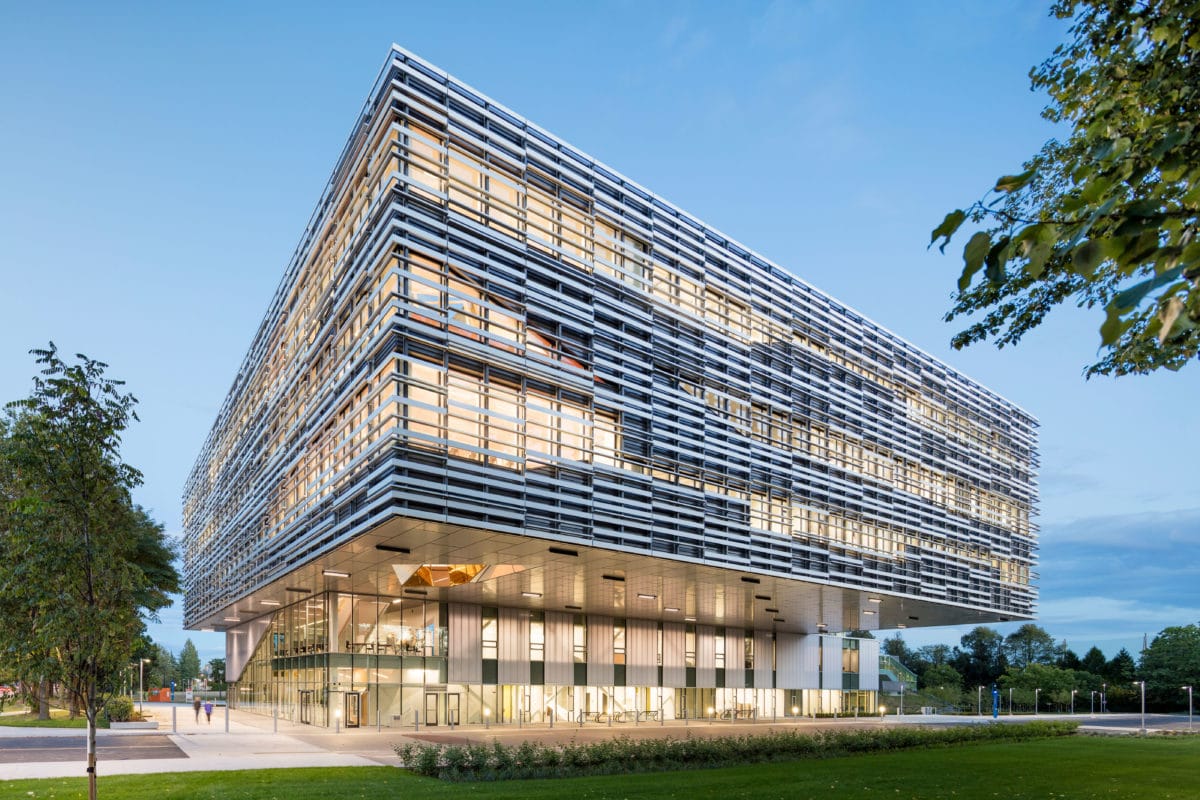Story at a glance:
- Daylighting refers to the practice of using passive or active systems to direct sunlight into a building’s interior for lighting purposes.
- The benefits of daylighting include improved health and productivity, lower operation costs, and fewer carbon emissions.
- Common daylighting strategies include windows, skylights, laylights, atriums, and more.
When it comes to lighting a room, natural daylight is difficult to beat. It’s energy-efficient, free, reduces eye strain, and even helps improve occupant health and productivity.
Considering that energy efficiency is a top concern of many architectural projects, more architects are working to include innovative daylighting solutions in their designs.
In this article we explore the basics of daylighting, its benefits, common implementation strategies, and a few standout examples.
What is Daylighting?
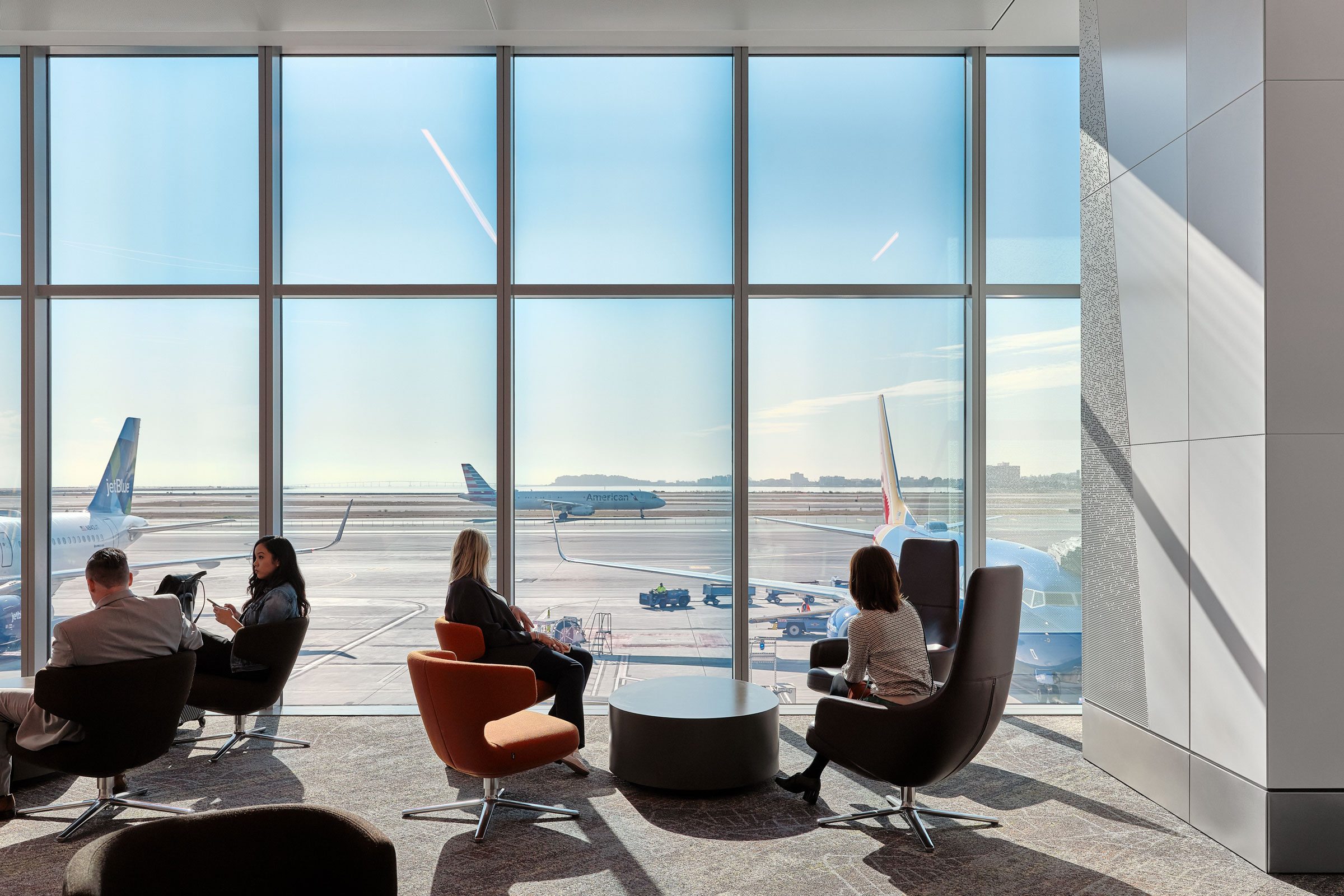
Natural light and comfortable seating dominate the waiting areas inside SFO Harvey Milk Terminal 1. Photo by Joe Fletcher
In the architectural sense daylighting simply refers to the practice of using natural sunlight—as opposed to electric light—to illuminate the interior of a building.
By using windows, skylights, reflective surfaces, and other light-admitting features, daylighting can make effective use of indirect or direct sunlight to reduce a structure’s energy loads and operating costs.
What are the Benefits of Daylighting?
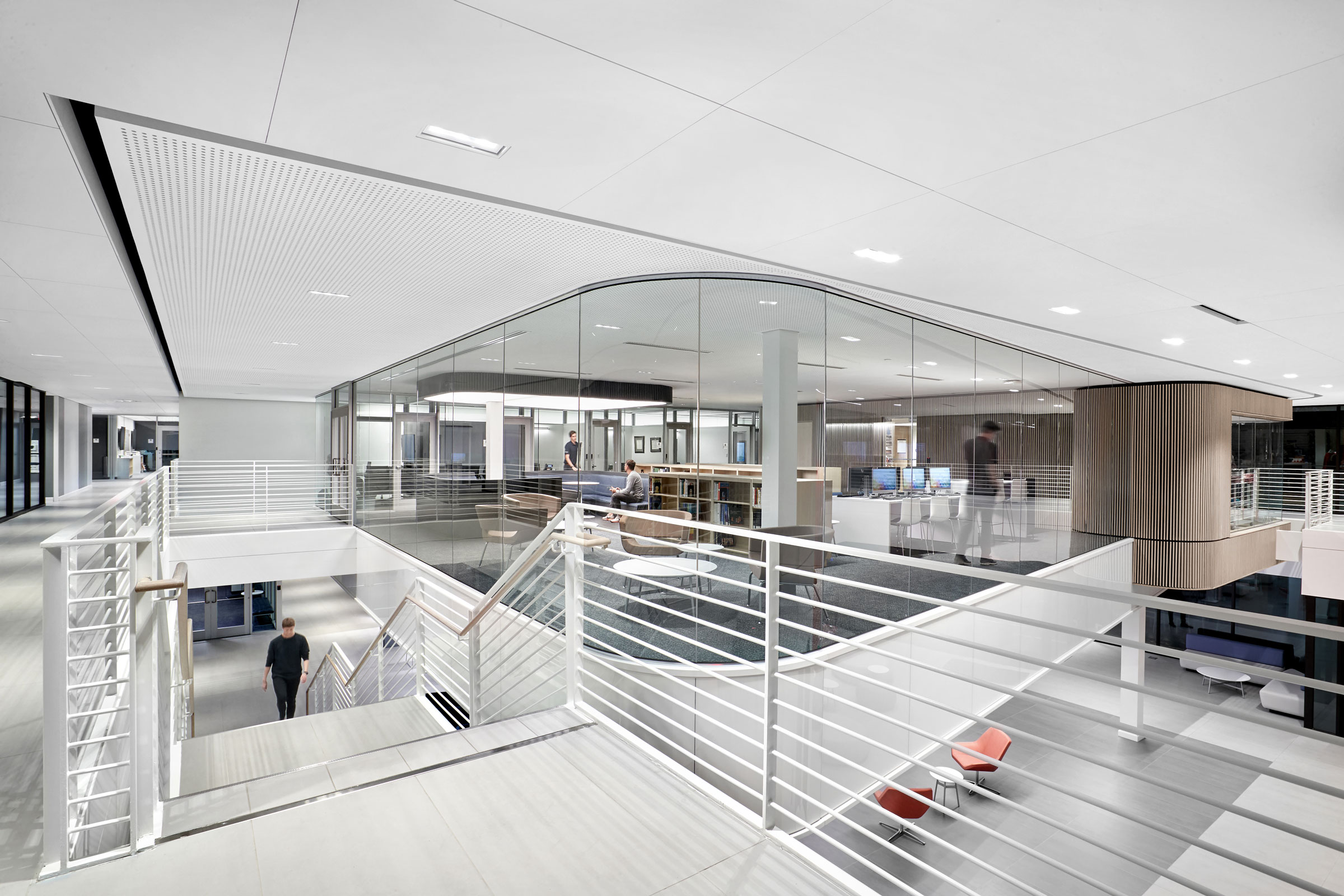
Perkins&Will used reflective surfaces in place of gypsum board to maximize natural light at Parker University in Dallas. Photo courtesy of Perkins&Will
It’s common knowledge that humans need sunlight to ensure adequate production of vitamin D—which helps the body absorb calcium and regulate cellular functions—but the benefits of daylighting in the built environment extend far beyond that.
Regulates Circadian Rhythm
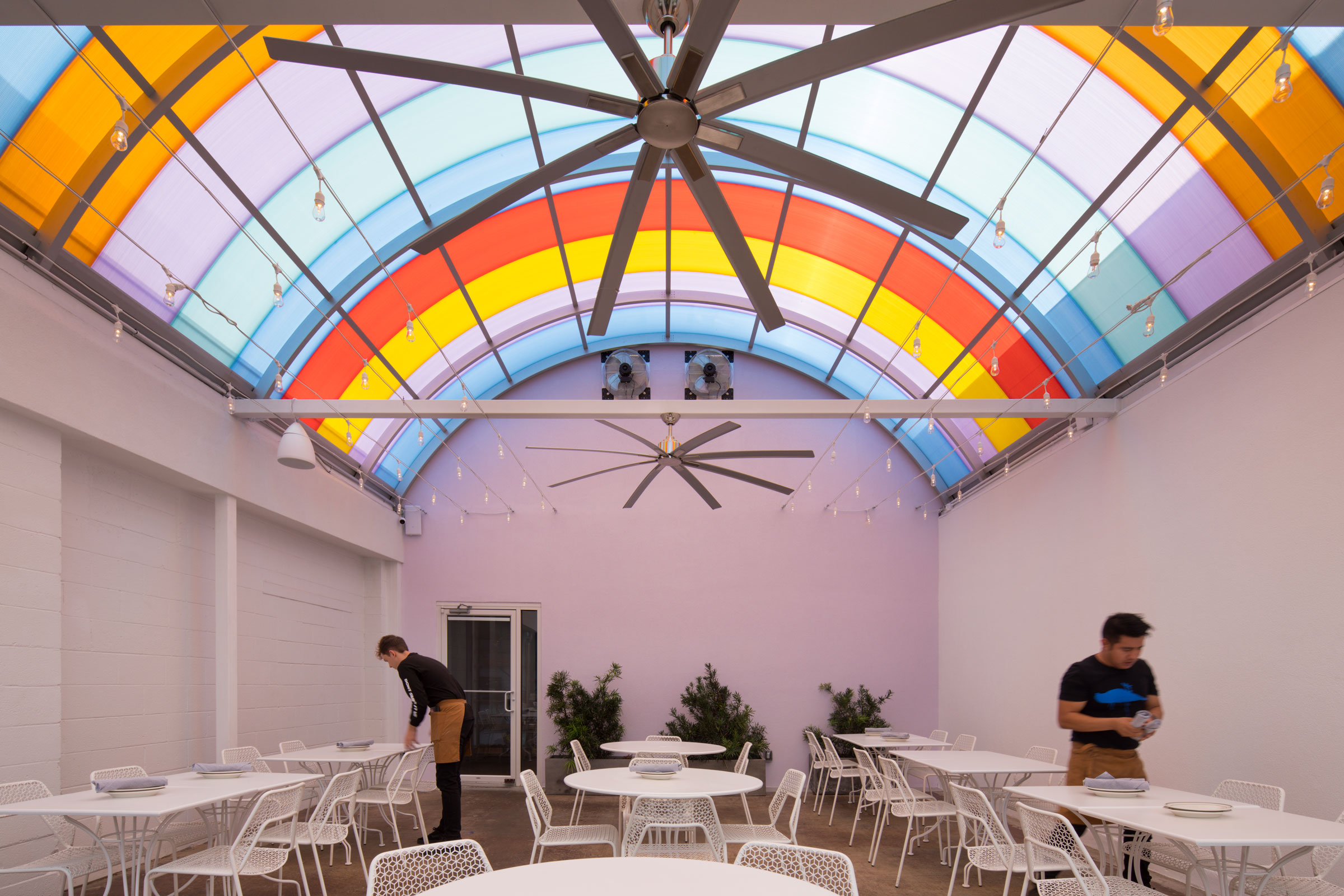
Kingspan Light + Air’s Briteway Canopy System offers shelter and protection for building occupants plus the benefits of diffuse natural light. Photo courtesy of Kingspan Light + Air
One of the most important benefits of daylighting is its role in providing the sunlight needed to keep our circadian rhythms in check.
“The human circadian rhythms are the body’s natural clock. When your brain detects daylight and the changing spectral content over the course of the day, it tells your body to wake you up, and when darkness hits, it triggers your body to fall asleep,” Neall Digert, vice president of innovation and market development at Kingspan Light + Air, previously wrote for gb&dPRO.
Poorly lit offices and classrooms can upset the body’s natural circadian rhythm, resulting in premature tiredness and low productivity. Proper daylighting helps prevent this.
“By exposing your body to daylight throughout the day, your healthy human circadian rhythm will have a significant role in regulating your sleep-wake cycle and have a positive influence on your eating habits and digestion, body temperature, hormone release, and other important bodily functions,” Digert says.
Improves Occupant Health
In the same vein, daylight is also scientifically proven to have a positive impact on both physical and psychological health.
Studies show that regular exposure to natural sunlight helps the human brain produce serotonin, a hormone that alleviates feelings of stress and anxiety. This makes sunlight an important part of the treatment process for managing—or even preventing—the onset of depression and seasonal-affective disorder.
There is also evidence to suggest that sunlight positively impacts physical health as well. Studies have shown that patients who are treated in facilities with ample daylight experience less pain and heal faster, resulting in lower medical expenses and reduced hospital stays.
Increases Productivity
By positively affecting the body’s circadian rhythm, daylighting also helps increase productivity by keeping the brain alert, reducing eye strain, and combating feelings of fatigue. Workplaces with sufficient daylighting see anywhere from a 5 to 40% uplift in productivity, according to research conducted by Eco Business.
Lowers Operating Costs
On average daylighting strategies can help reduce energy costs by at least one-third, saving homes and businesses a large sum of money on their annual operating costs.
Reduces Greenhouse Gas Emissions
By reducing the amount of energy needed to illuminate and heat a space, daylighting effectively results in fewer greenhouse gas emissions. This is one of the most important benefits of daylighting, as carbon emissions are the driving factor behind accelerated anthropogenic climate change.
Types of Daylighting
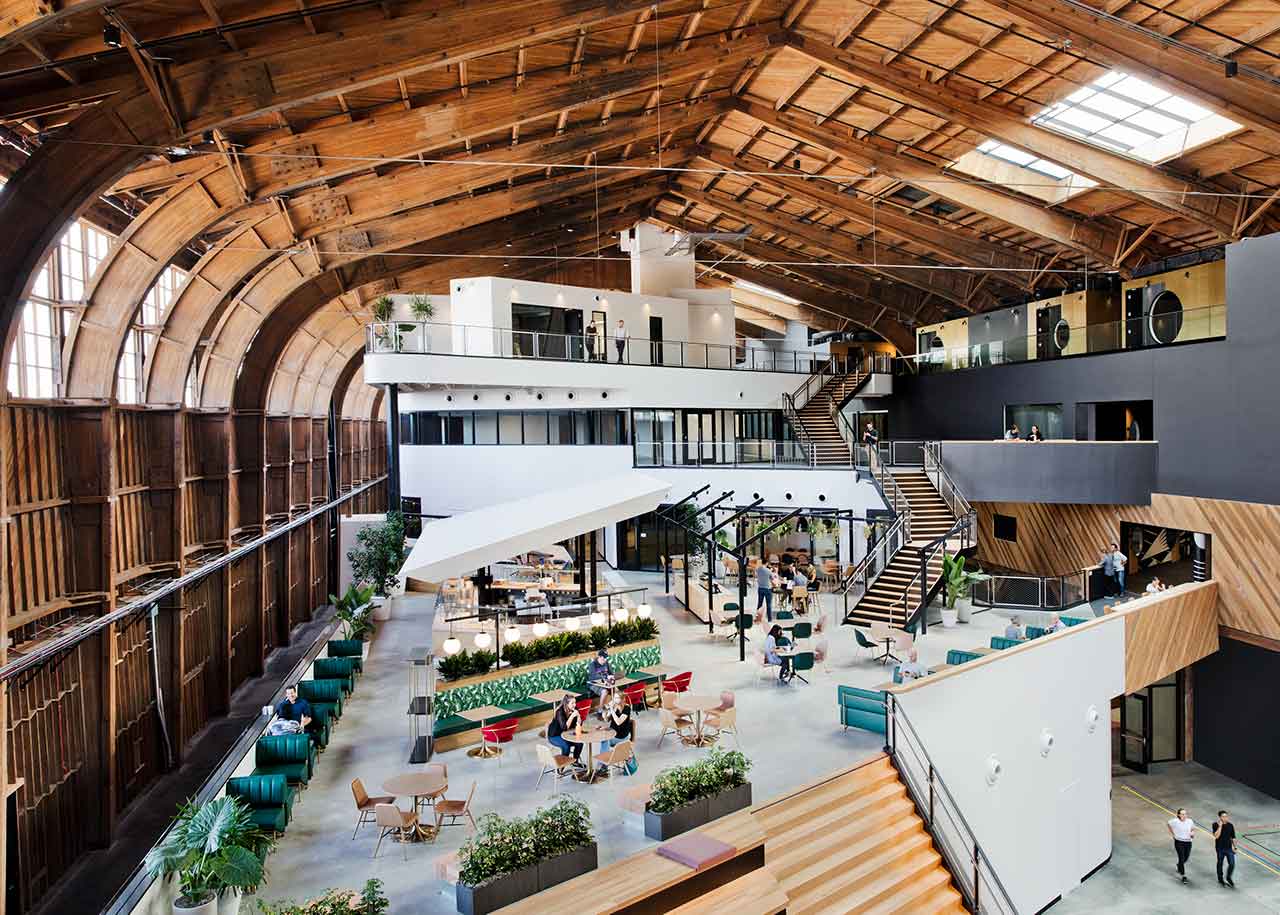
Large windows and skylights illuminate the ZGF-designed Google Spruce Goose. Photo by Connie Zhou
There are a wide range of daylighting strategies, all of which fall into one of two categories: passive or active.
Passive Daylighting Strategies
As the name suggests, passive daylighting strategies are static, non-moving features that do not require the use of mechanical components or systems to collect and reflect light into a building.
Passive daylighting encompasses some of the oldest lighting strategies and may be realized in a variety of ways.
Windows & Doors
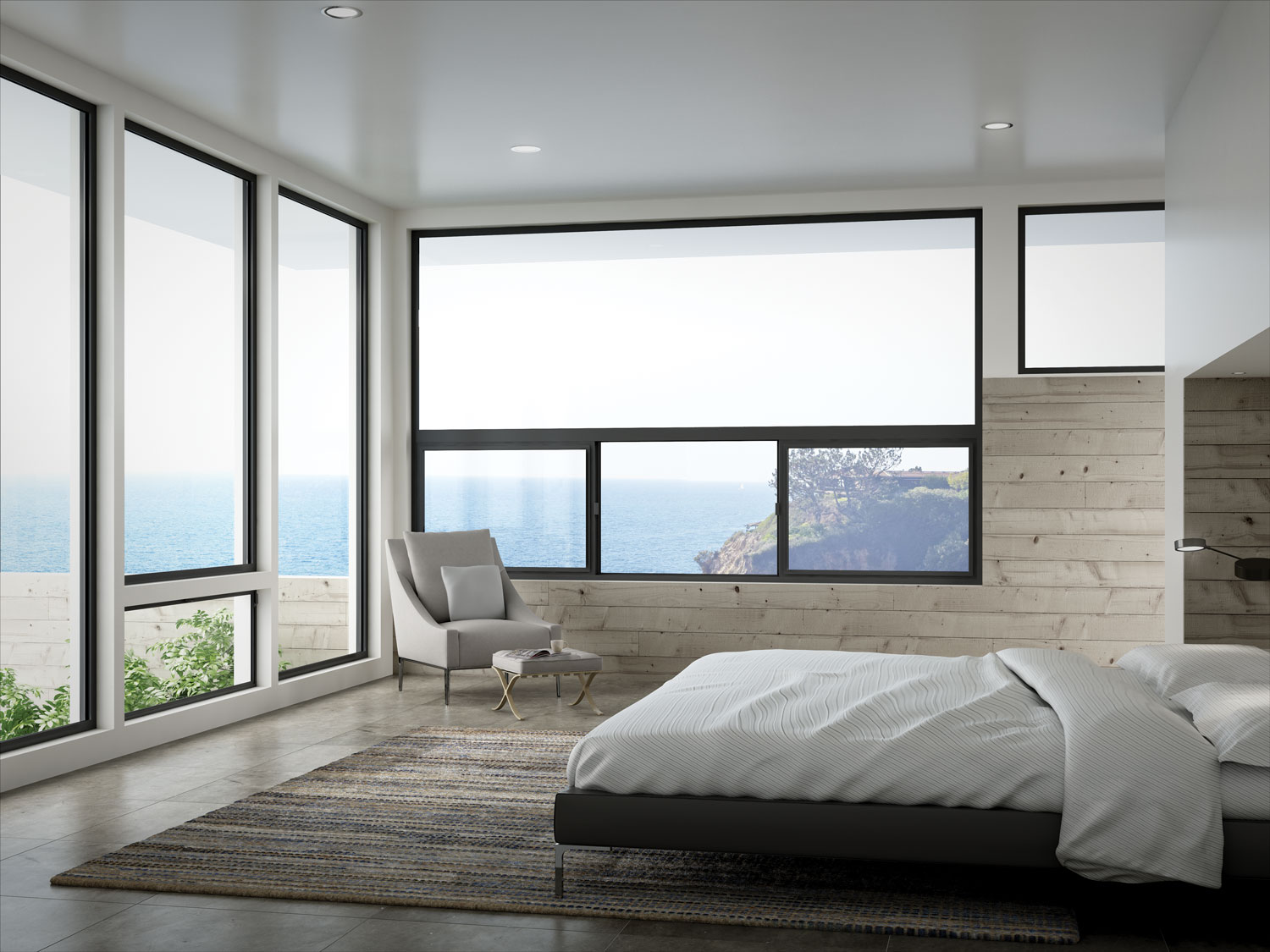
Windows are the easiest daylighting strategy to implement. Photo courtesy of Milgard
Of all the passive daylighting strategies, it should come as no surprise that windows are the most widespread. Windows vary considerably in the amount of daylight they admit depending on glaze type (which dictates the window’s visual light transmittance), treatment, and the grade of glass, as well as the physical positioning and orientation of the window itself.
Clerestory windows are one of the most useful types of windows for passive daylighting purposes, as they sit high up on a wall—above eye level—and allow ambient sunlight to reach deeper into a room. When opened, clerestory windows also serve as passive ventilators and can help better regulate interior temperatures.
To a lesser extent, doors may serve as daylighting devices, provided they are composed primarily of glass (such as those found in most commercial structures).
Atriums
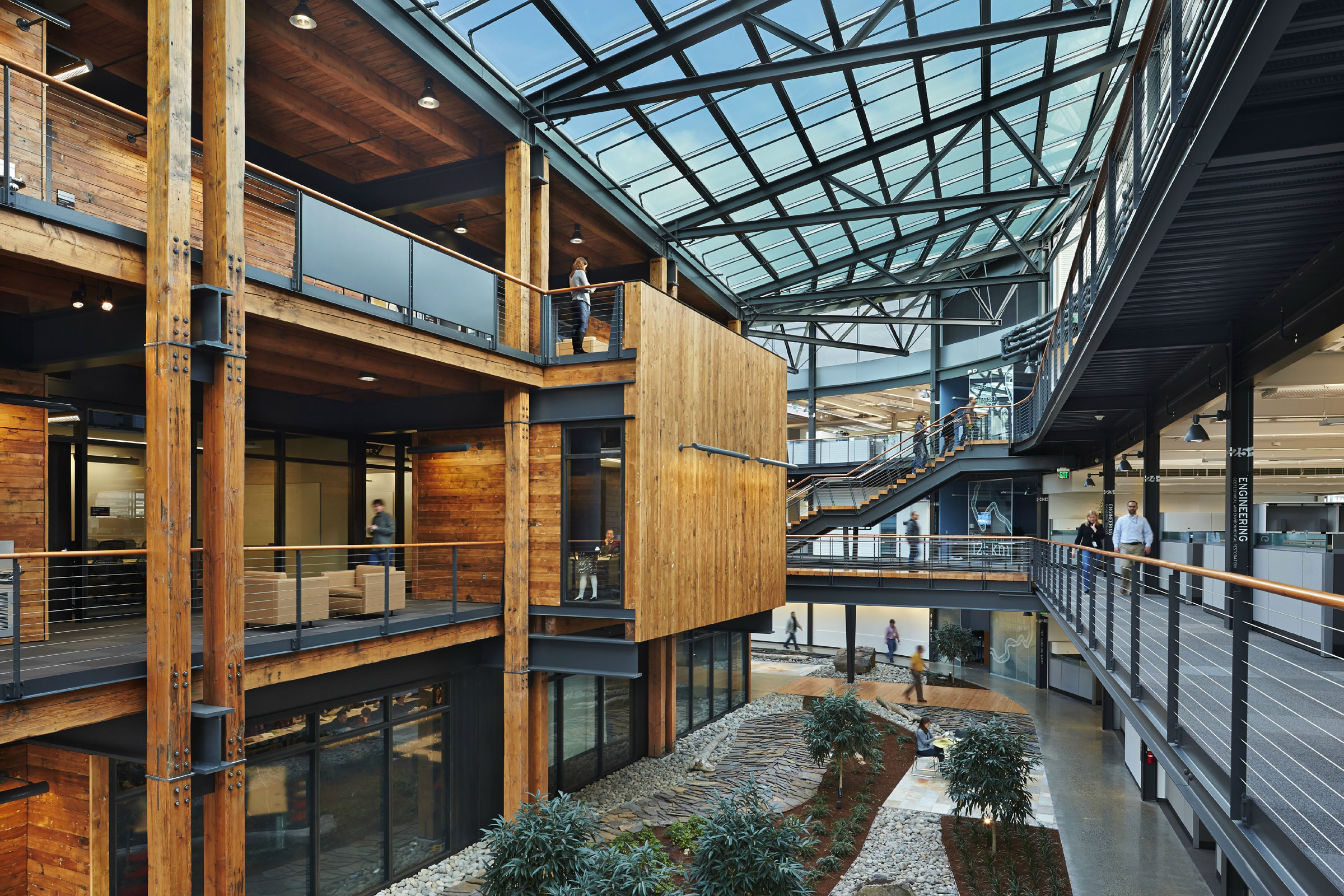
Federal Center South’s atrium has radiant heating in its aluminum ceiling frame, showing off the design flexibility of radiant systems. Photo courtesy of Barcol-Air
Traditionally, atriums—be they glass-walled or glass-roofed—have served to illuminate large, centralized spaces in buildings. Atria are typically several stories high and provide both daylight and a visual link to the outside world, resulting in a dynamic lighting feature that is both impressive and practical.
Atriums offer some measure of daylight to adjacent areas not directly beneath them, but this is largely restricted to the uppermost floors. Atria can help to illuminate lower stories, but only if the floor and walls are capable of reflecting light.
Skylights & Laylights
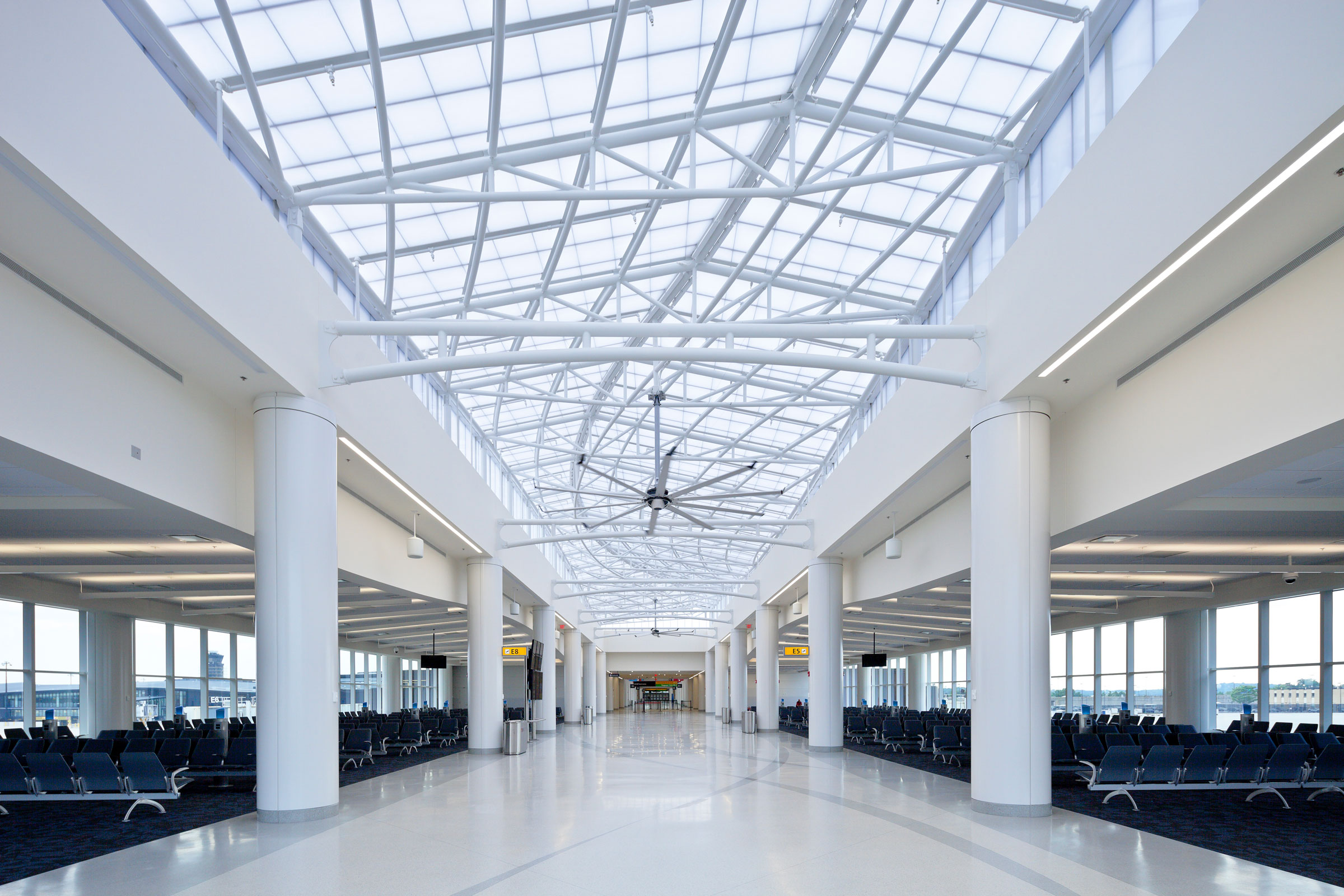
Specular architectural finishes like polished concrete at BWI Airport seen here interact with diffused light from a translucent linear architectural skylight. This creates sparkle—reinforcing the essence of what we expect from daylight. Photo courtesy of Solatube
Another popular form of daylighting is skylights—or those large glass panes that may be used to form all or a portion of a building’s roof space. Skylights permit light to enter a structure and also offer protection from the elements. Depending on the type of skylight, they may also serve ventilation purposes.
Operable skylights, for example, feature a hinged sash and can be opened in much the same way a traditional window may be opened. This is also true of retractable skylights, which sit on steel tracks that allow them to roll open.
Laylights, on the other hand, are glazed panels that sit flush with the ceiling of an interior space, rather than the roof itself. They are often made from stained glass and typically serve as both a source of illumination and as decoration. Laylights aren’t, however, able to be used for ventilation purposes and do not provide protection from the elements.
If desired laylights may be paired with skylights to maximize efficiency. This combination serves to diffuse light throughout an interior space with less glare.
Translucent Walls
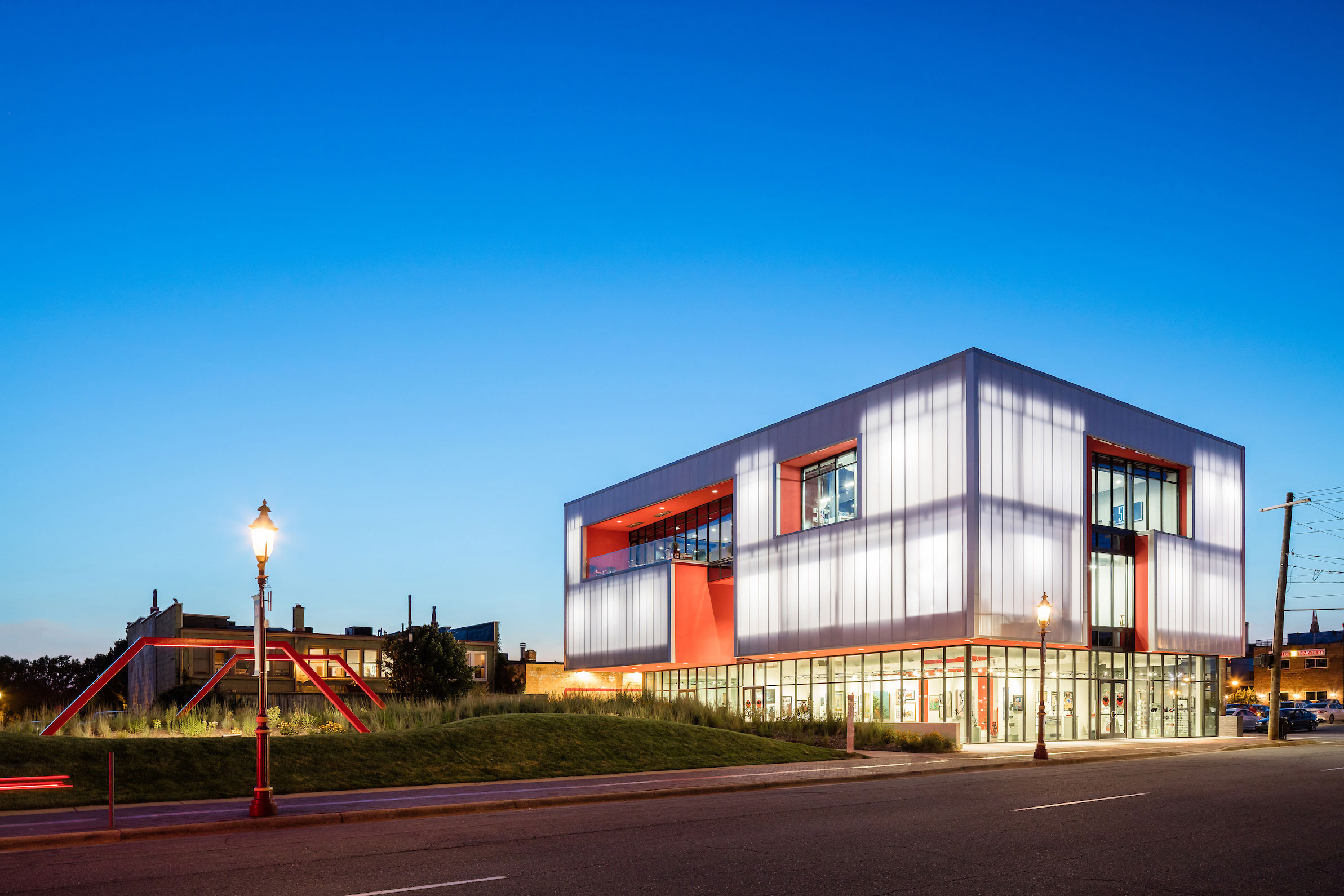
The Art for Art’s Sake building in North Carolina uses a UniQuad translucent wall system building. Photo by Keith Isaacs
In terms of daylighting strategies, there are two main types of translucent walls: glass brick and panels.
Glass brick walls are the oldest form of translucent wall and are composed of thick glass blocks stacked atop one another. Color and level of translucency can vary depending on how the blocks are prepared.
Alternatively, large translucent panels—be they glass or polycarbonate—may be used to form or cover walls on a larger scale. Translucent panels are favored due to the fact that they diffuse the sunlight they receive into glare-free daylight that can be used to illuminate interiors (while also providing privacy in the process).
Prisms
Originally used to light the lower decks of ships, prisms can help reflect light downwards and sideways, throwing daylight into the deepest, darkest parts of a room. Today most prisms are positioned in the upper portions of windows and serve to bend light upwards, where it can then wash across ceilings.
Light Tubes
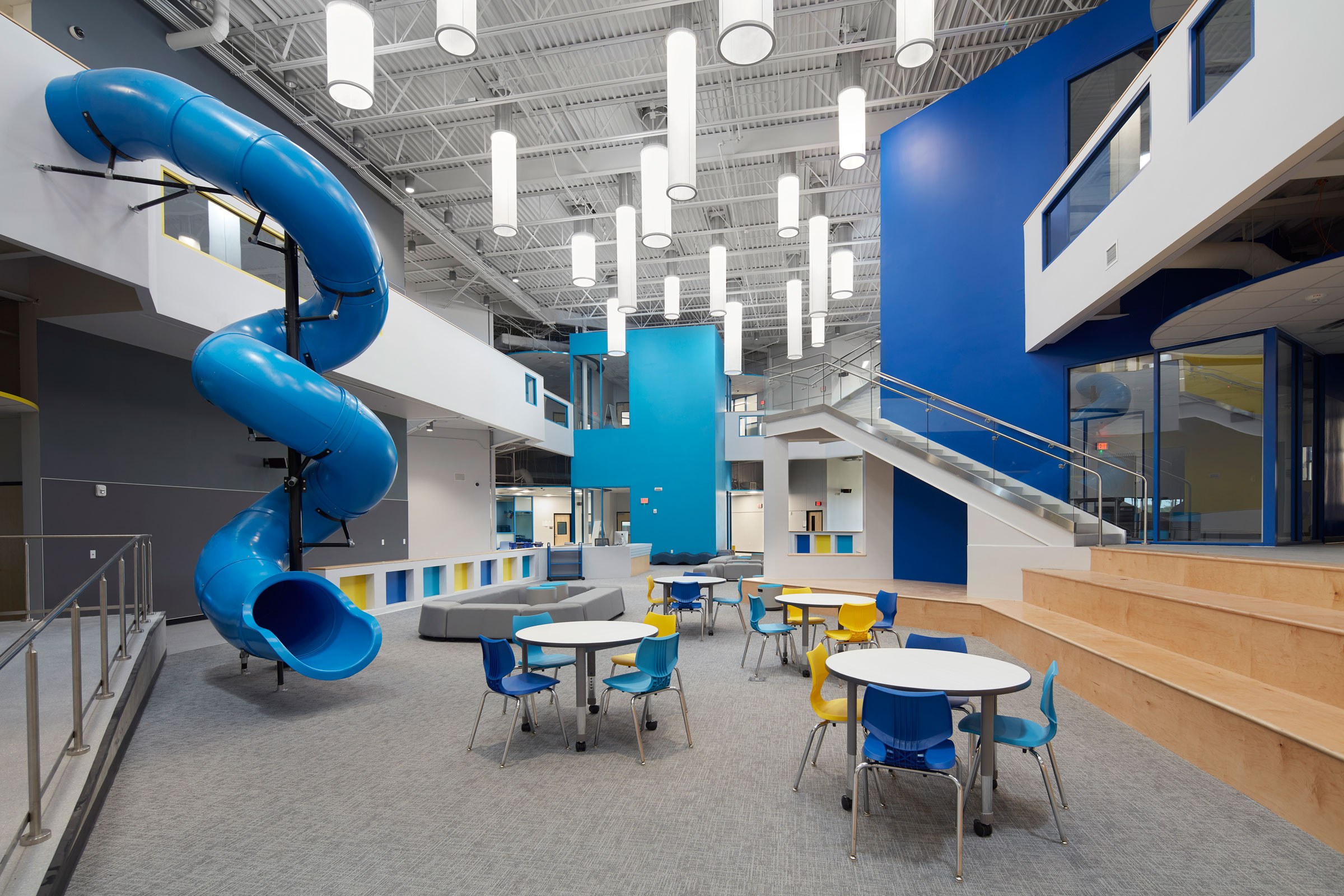
The Sunnyvale ISD Intermediate School in Texas uses Solatube TDDs with luminous shades. Photo courtesy of Solatube International
While the technique has been used since the construction of Egypt’s great pyramids, tubular daylighting devices (TDDs) were first patented in 1986 by Solatube International of Australia.
These devices function similarly to skylights in that they are installed on rooftops, where they then harvest sunlight, transfer it through a highly reflective tube, and distribute it evenly throughout an interior space by way of a diffuser.
TDDs are so adept at capturing and reflecting sunlight that they are able to adequately light up a room even on cloudy days.
Active Daylighting Strategies
There are also what’s called active daylighting strategies, which describe those systems that are mechanical in nature and use mechanisms to actively track or follow the sun throughout the day to collect and provide sunlight. Most active daylighting systems use a series of mirrors and lenses to direct and concentrate light into distribution tubes.
There are two types of active solar tracking systems: closed-loop and open-loop.
Closed-loop Systems
A closed-loop daylighting system uses sensors or lenses to track the sun throughout the day. Designed to be fully illuminated at any given moment, the sensors are directed at the sun and have a very limited field-of-view—when the sun moves and a sensor becomes shaded, the system moves accordingly.
Open-loop Systems
Open-loop daylighting systems, on the other hand, do not rely on sensors to track the sun. Instead they use a pre-programmed mathematical sun chart that details the sun’s location at any given date and time for a specific locale.
Using this information, the system follows the sun throughout the day without the aid of external factors.
Examples of Daylighting
Now that we’ve familiarized ourselves with various types of daylighting strategies, let’s take a look at a few real-world examples.
Hope Lodge

The Perkins&Will Hope Lodge project was designed to locate all of the programs on the building perimeter and put the circulation route around the healing garden. Photo by James Steinkamp
Designed by Perkins&Will, the Hope Lodge cancer center in Houston shows just how important daylighting can be from a health standpoint.
Built for the American Cancer Society, Hope Lodge treats daylight as an absolute necessity, especially when it comes to easing the stress and anxiety felt by cancer patients. All of the facility’s communal spaces surround a central garden and large windows allow sunlight to filter into the program rooms.
“As you move through the space you’re moving along this beautiful healing garden with really nice, dappled light, and that’s creating a more welcoming and comforting environment for patients and their families,” Tori Wickard, senior project architect at Perkins&Will, previously told gb&d.
Floor-to-ceiling windows make up the lodge’s ground-floor walls, reducing the need for artificial lighting during daytime hours.
Andy Quattlebaum Outdoor Recreation Center
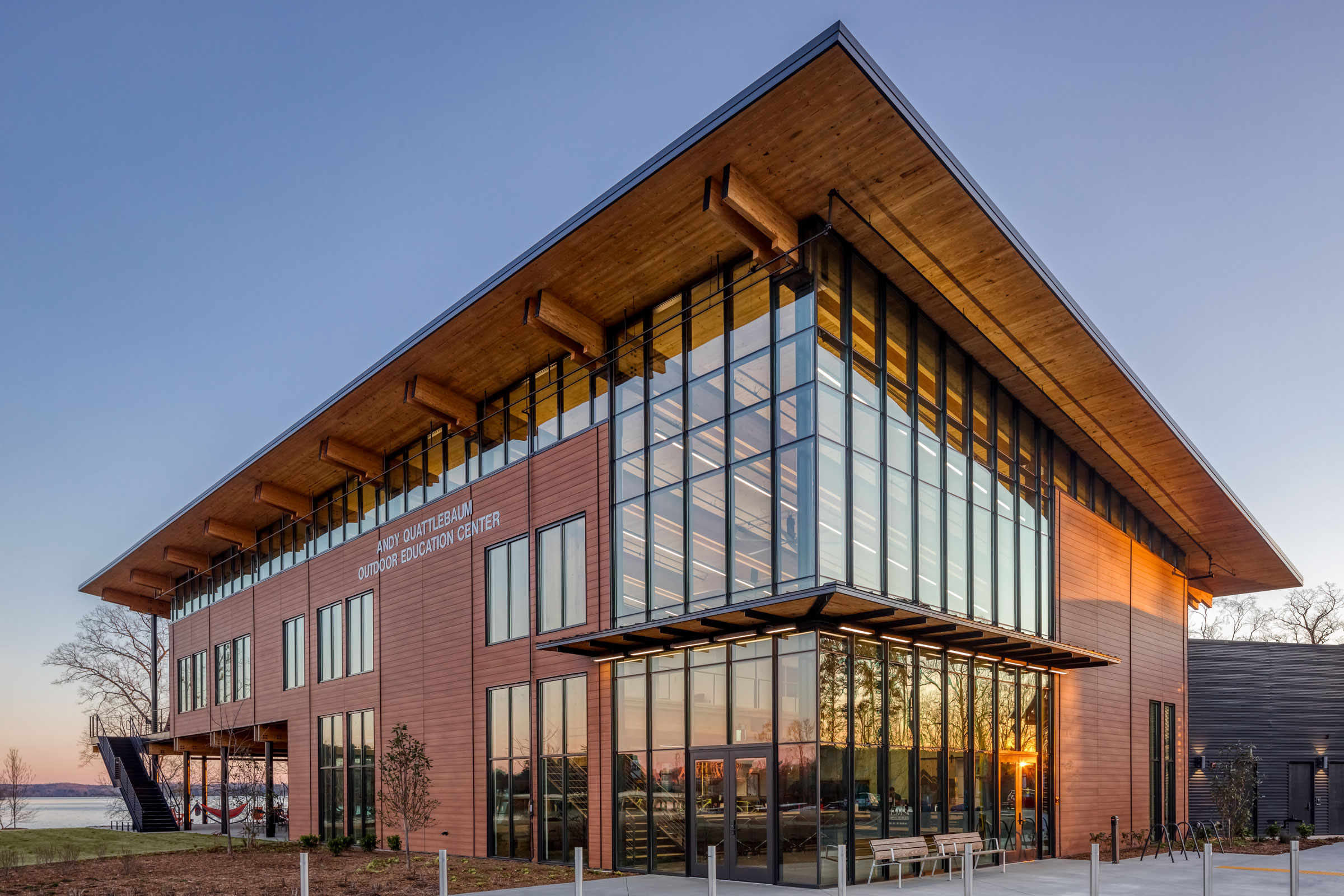
The new Andy Quattlebaum Outdoor Recreation Center at Clemson University was designed by Cooper Carry in collaboration with Clemson University’s Wood Utilization + Design Institute. Photo by Jonathan Hillyer
Designed for Clemson University and designed by Cooper Carry in collaboration with the CU Wood Utilization and Design Institute, the Andy Quattlebaum Outdoor Recreation Center combines traditional daylighting strategies with smart-lighting technology for maximum efficiency.
Sporting a facade wrapped in tall vertical windows, the center receives plentiful sunlight throughout the year and offers stellar views of the surrounding natural landscape. Sensor-controlled monitored light systems ensure that artificial lighting only comes on when absolutely necessary.
Adequate admittance of natural sunlight was a priority for the recreation center, in large part due to daylight’s role in facilitating a healthy body and mind.
Langara Science & Technology Building
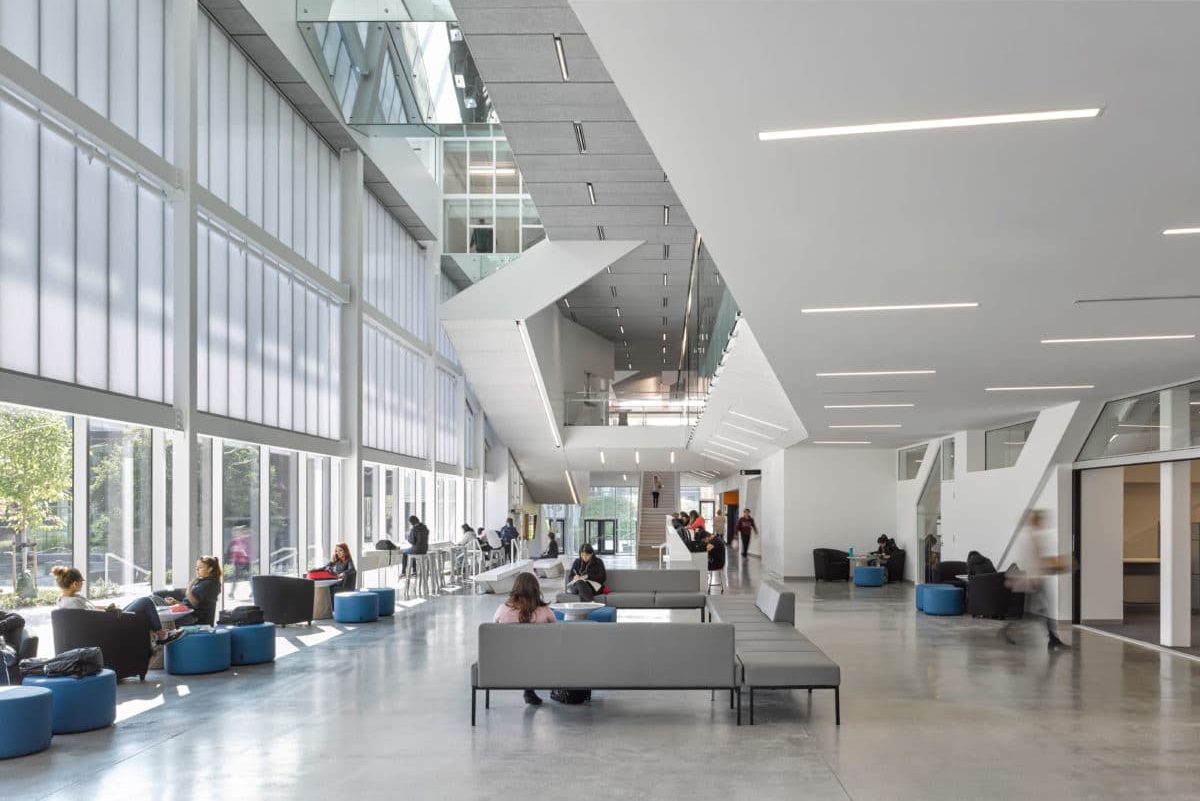
Natural light fills the Langara Science & Technology building, from a massive light well to large windows in classrooms. Photo by Andrew Latreille
Designed by Proscenium Architecture + Interiors Inc. (PAI) and located in Vancouver, the Langara Science and Technology Building is a modern marvel of daylighting strategies.
In order to make the most out of available sunlight, the building employs a light well—an open space within a structure that aids in ventilation and allows light to reach the innermost rooms—and a skylight on its west side. The building’s multi-story Vortex Lounge also aids in daylighting by allowing sunlight to penetrate through to the lower floors.
“The more natural light we can get to penetrate the building, the less ambient lighting we need to use, thereby reducing energy consumption. The challenge is controlling glare,” architect Kori Chan of PAI previously told gb&d.
This led to the widespread usage of translucent polycarbonate wall panels and architectural screening, both of which help to diffuse daylight before it enters the building.
Spoke Luxury Apartments’ Parking Garage

Daylighting solutions from Kingspan Light + Air (KLA) transformed this parking garage in Chicago. Photo courtesy of Kingspan Light + Air
In Chicago, the Spoke Luxury Apartments’ parking garage showcases how daylighting solutions can transform otherwise drab, industrial-type structures.
To keep the parking garage from detracting from the apartment building’s overall appearance, Kingspan Light + Air clad the structure in light-blue translucent glazing panels. These were chosen over traditional aluminum or metal siding panels as they naturally diffuse sunlight, eliminating the need for constant artificial lighting.
“Nobody wants to walk around a dark parking garage,” David Gregory, senior architectural support specialist at Kingspan Light + Air and Solatube, previously told gb&d. “This glazing system allowed for an aesthetic appeal from the outside and brought a lot of light to the inside where it would normally be dark.”
Due to the fact that the glazing panels transmit light in both directions, the parking garage emits a soft glow at night, making it a beacon for the city.
Flora Arca Mata Elementary
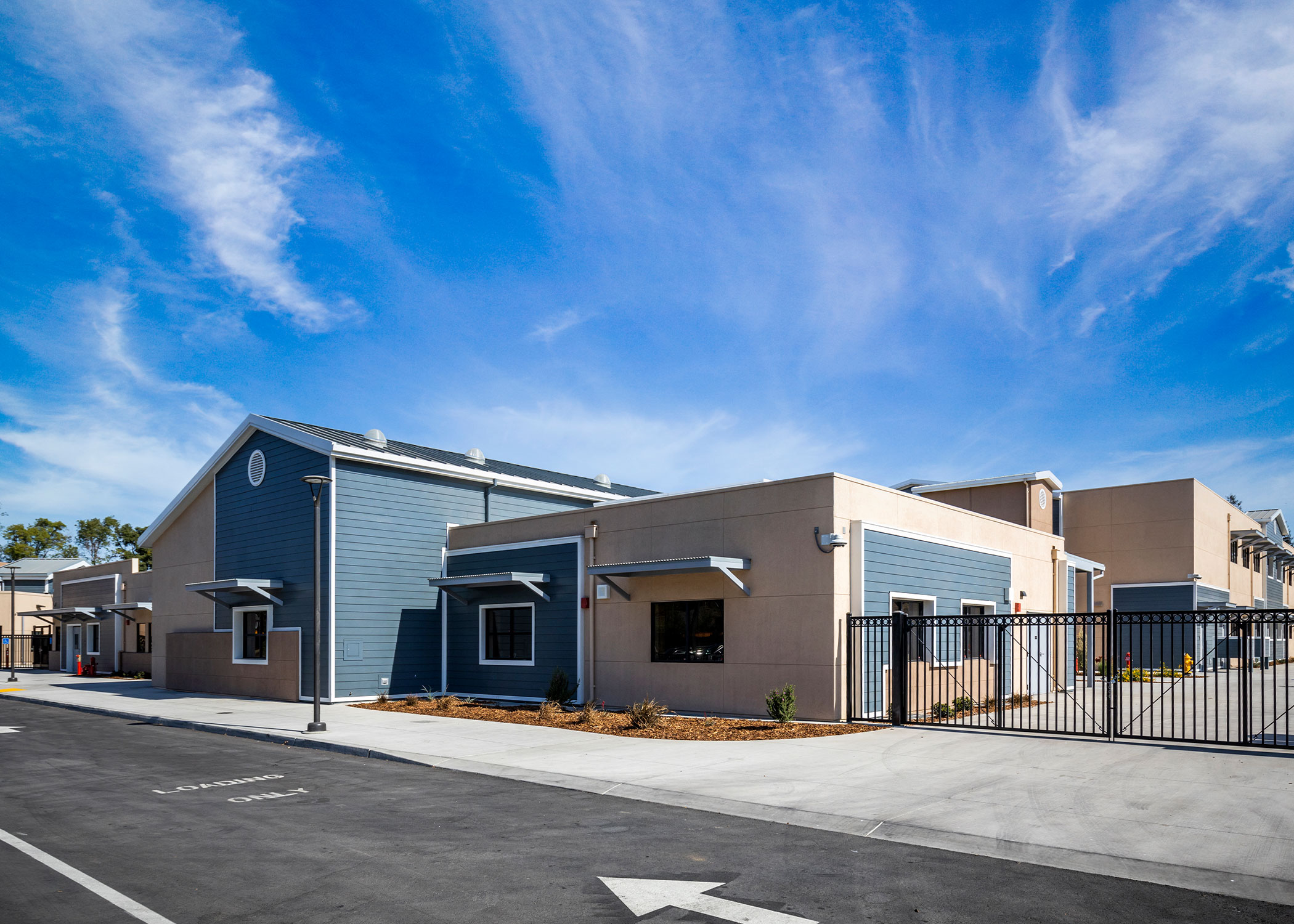
Flora Arca Elementary used Solatube’s SolaMaster Series 750 DS to bring ample daylight into the educational space. Photo courtesy of American Modular Systems
Located in Stockton, California and designed by TETER Architects + Engineers, the Flora Arca Mata Elementary School is an inspiring example of tubular daylighting in action.
Due to the design constraints imposed by the client, large windows—such as those typically found in schools—would not be able to provide the amount of light necessary to properly illuminate the classrooms. As a result, the school instead makes extensive use of Solatube’s tubular daylighting systems.
These light tubes collect sunlight from the rooftop and funnel it through highly reflective tubes into the classrooms below, providing consistent illumination throughout the day. In this manner, students are still able to receive the positive cognitive and psychological benefits of sunlight without requiring the installation of large windows.
Solatube also provided Daylight Dimmers for each system installed, giving teachers the ability to easily adjust classroom daylight levels.
Eugene Civic Park
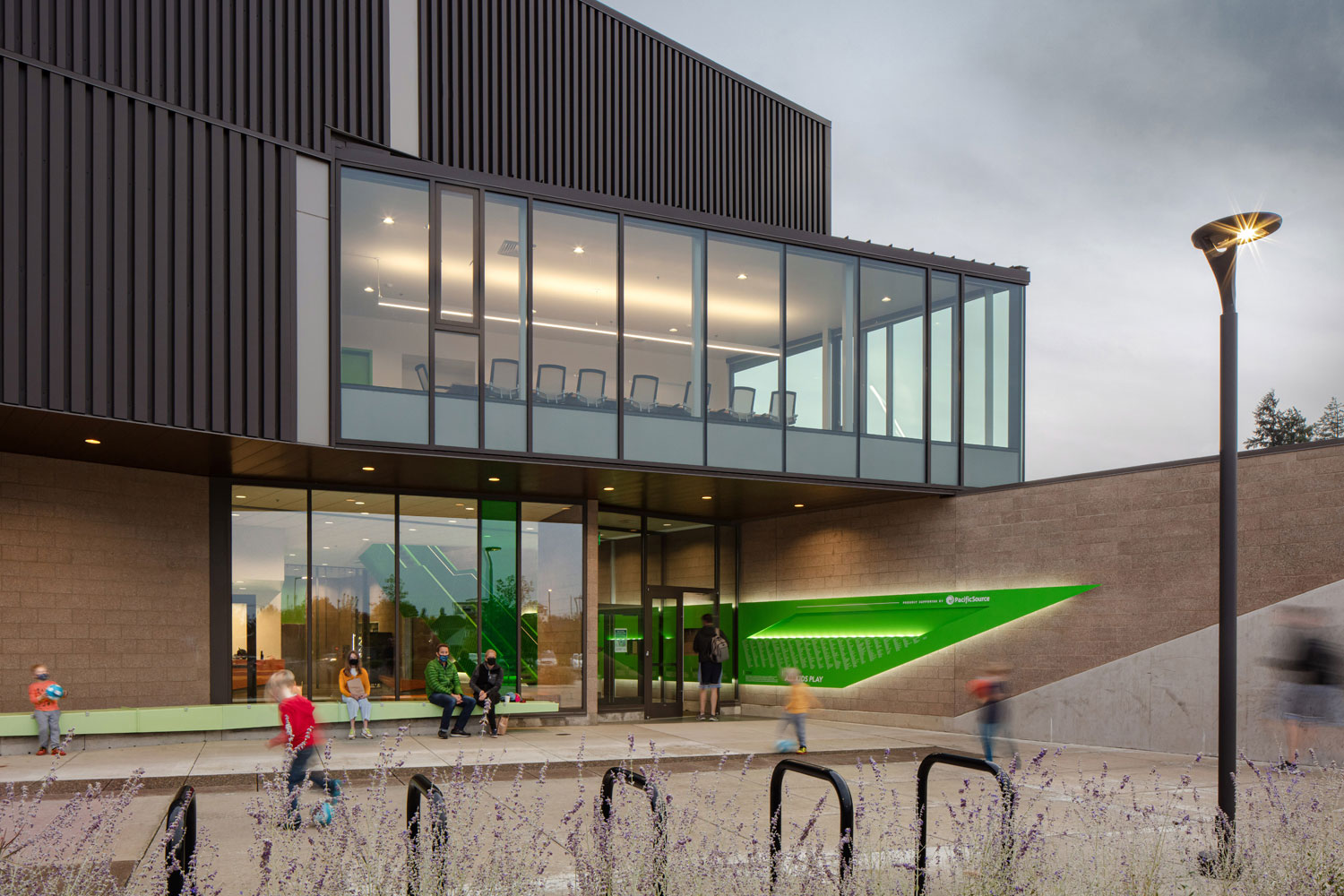
Angled north-facing clerestories flood the six field house multipurpose courts with daylight and will visually connect to the grandstand, which will be located across the outdoor sports fields. Photo by Stephen A. Miller
Designed by Skylab Architecture, the new Civic Park in Eugene Oregon places daylighting at the forefront, especially as it relates to sustainability.
Built to replace the Eugene Civic Stadium, Civic Park houses a fieldhouse, stadium, and multiple sports fields. Of these, the fieldhouse is most impressive when it comes to daylighting; the building features high, east-facing windows that maximize natural light admittance and offer unobstructed views of the surrounding courts.
“Supervision and safety are enhanced through this transparency, as well as the ability of the courts to function with 100% natural lighting,” Jamin Aasum, project architect at Skylab, previously told gb&d. “All electrical lighting is controlled with daylight sensors to automatically adjust lighting levels and save energy.”

